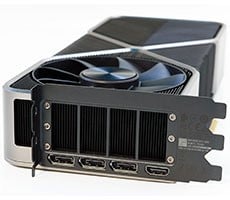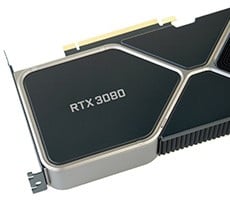
The mainstream video card market is about to get a shot in the arm courtesy of the folks at NVIDIA. Today the company is officially unveiling a new addition to their popular GeForce 6 Series of products, the GeForce 6800 GS. The GeForce 6800 GS is a new 12-pipeline, mainstream product, that promises relatively high-performance at a much more affordable price than the flagship products of today. We were recently given the opportunity to evaluate the new GeForce 6800 GS, so armed with a few other mainstream video cards, some that are currently available (Radeon X800 XL & GeForce 6800 GT) and one that is not available just yet (Radeon X1600 XT), we decided to see how NVIDIA's new product stacked up. Read on to see what we found out. You'll be happy you did...
 |
| Specifications & Features of the GeForce 6800 GS |
| A More Powerful Mainstream NV4x |
|
CINEFX 3.0 SHADING ARCHITECTURE
- Vertex Shaders
Support for Microsoft DirectX 9.0 Vertex Shader 3.0
Displacement mapping
Vertex frequency stream divider
Infinite length vertex programs*
- Pixel Shaders
Support for DirectX 9.0 Pixel Shader 3.0
Full pixel branching support
Support for Multiple Render Targets (MRTs)
Infinite length pixel programs*
- Next-Generation Texture Engine
Up to 16 textures per rendering pass
Support for 16-bit floating point format and 32-bit floating point format
Support for non-power of two textures
Support for sRGB texture format for gamma textures
DirectX and S3TC texture compression
- Full 128-bit studio-quality floating point precision through the entire rendering pipeline with native hardware support for 32bpp, 64bpp, and 128bpp rendering modes
NVIDIA HIGH-PRECISION DYNAMIC-RANGE (HPDR) TECHNOLOGY
- Full floating point support throughout entire pipeline
- Floating point filtering improves the quality of images in motion
- Floating point texturing drives new levels of clarity and image detail
- Floating point frame buffer blending gives detail to special effects like motion blur and explosions
- New rotated-grid anti-aliasing removes jagged edges for incredible edge quality
INTELLISAMPLE 3.0 TECHNOLOGY
- Advanced 16x anisotropic filtering
- Blistering-fast anti-aliasing and compression performance
- Support for advanced lossless compression algorithms for color, texture, and z-data at even higher resolutions and frame rates
- Fast z-clear
- High-resolution compression technology (HCT) increases performance at higher resolutions through advances in compression technology
ULTRASHADOW II TECHNOLOGY
- Designed to enhance the performance of shadow-intensive games, like id Software's Doom III
|
ADVANCED ENGINEERING
- Designed for PCI Express x16
- Support for the industry's fastest GDDR3 memory
- 256-bit advanced memory interface
- 0.11 micron process technology
- Advanced thermal management and thermal monitoring
ADVANCED VIDEO AND DISPLAY FUNCTIONALITY
- Dedicated on-chip video processor
- MPEG video encode and decode
- WMV9 decode acceleration
- Advanced adaptive de-interlacing
- High-quality video scaling and filtering
- Integrated NTSC/PAL TV encoder supporting resolutions up to 1024x768 without the need for panning with built-in Macrovision copy protection
- DVD and HDTV-ready MPEG-2 decoding up to 1920x1080i resolutions
- Dual integrated 400 MHz RAMDACs for display resolutions up to and including 2048x1536 at 85Hz.
- Dual DVO ports for interfacing to external TMDS transmitters and external TV encoders
- Microsoft Video Mixing Renderer (VMR) supports multiple video windows with full video quality and features in each window
- VIP 1.1 interface support for video-in function
- Full NVIDIA nView multi-display technology capability
NVIDIA DIGITAL VIBRANCE CONTROL (DVC) 3.0
- DVC color controls
- DVC image sharpening controls
OPERATING SYSTEMS
- Windows XP
- Windows ME
- Windows 2000
- Windows 9X
- Macintosh OS, including OS X
- Linux
API SUPPORT
- Complete DirectX support, including the latest version of Microsoft DirectX 9.0
- Full OpenGL, including OpenGL 1.5
* The operating system or APIs can impose limits, but the hardware does not limit shader program length.
|
The chip formerly codenamed NV42 has become the GeForce 6800 GS. As its name implies, the GeForce 6800 GS is a new addition to the GeForce 6 Series, and as such it offers essentially the same feature set as the older GeForce 6 cards that came before it. To name just a few, the NVIDIA GeForce 6800 GS has full support for Shader Model 3.0 features, including the Vertex Texture Fetch (VTF) capability missing from ATI's recently introduced X1K series of products. The GeForce 6800 GS also has support for 64-bit floating point texture filtering for high dynamic-range (HDR) lighting effects, NVIDIA's PureVideo on-chip video processor is present as well, and the GS fully supports SLI (Scalable Link Interface) for higher-performance, dual-board graphics support. For more information on the GeForce 6 architecture, we recommend taking a look at this article, and more information about SLI is available here.
The GPU at the core of the GeForce 6800 GS features 12 pixel-pipelines, 5 vertex shaders, and a 256-bit memory interface. And the GPU is manufactured on a .11 micron (110 nanometer) process. Strictly from a feature standpoint, the GeForce 6800 GS is much like the older 12-pipe GeForce 6800, but due to some refinements to the core, the use of a more advanced .11 micron manufacturing process, and GDDR3 memory, NVIDIA was able to ramp clock speeds much higher than their previous 12-pipe product.







